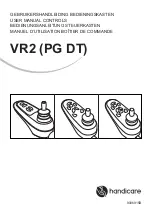
8
|
ni.com
|
NI 9759 User Manual
The throttle control algorithm involves four major functions:
1.
The angle setpoint (reference), ThetaR is compensated by a user defined lead and lag time.
These parameters will sharpen or dull the changes in setpoint.
2.
A proportional, integral and derivative action is calculated based on two sets of PID gains,
above or below the default limp-home region. The reason for two sets of gains is because
electronic throttle bodies typically have stiffer spring return rates applied to angles below
the limp-home region.
3.
A limp-home compensation value is added to the PID value to assist with travel through the
limp-home region. This compensation can minimize the flat control spot often found as the
throttle plate moves through the limp-home region.
4.
A stiction compensation value is added to the PID value to assist with small error control.
When the throttle plate approaches the setpoint, stiction in the throttle motor gearing can be
significant enough such that PID control alone will cause integral overshoot. Stiction
compensation will apply small alternating forces to assist the PID integral action.
5.
Battery voltage compensation is optionally added to the final output to compensate for
battery voltage fluctuations away from the nominal voltage.
In general, the final voltage u (V) is a sum of three components and optionally multiplied by a
battery compensation factor:
u (V) = [PID(V) + Stiction Comp(V) + Limp-Home Comp(V)] × Battery Comp Factor
The first calibration which the user should tune is throttle angle versus sensor voltage. A linear
equation can be used, as well as a two-point 1D lookup table.
1.
Manually close the throttle plate completely to determine the minimum sensor voltage. If
the radii of the throttle body opening and the throttle plate are measured, then the minimum
throttle angle can be calculated by using an inverse cosine calculation, or by approximating
the small angle with sine.
2.
Manually open the throttle plate to wide-open-throttle, noting the maximum sensor voltage.
3.
Assume the wide-open-throttle angle to be 90 degrees.
4.
After calibrating for position versus voltage, enter the value for ThetaLH (default
limp-home position). It is recommended that the sensor voltages entered into the position
calibration for the upper and lower limits be slightly narrowed so that position control at
these points does not overwork the driver, trying to achieve positions that are not possible
as sensing conditions change. Another way to prevent this condition is to limit the setpoint
range to a small position away from the physical limits.
5.
Implement a filter on throttle position. A second order, lowpass Butterworth filter with a
cuttoff frequency of 25 Hz is suggested. The filter is most effective during small-error
control.
6.
The
throttle_rt_data_convert_revx.vi
already implements a 25 Hz filter on the
analog input voltages. If this VI is used for position, a filter is not required.
7.
Begin control calibration with zero for all Lead/Lag, PID and compensation calibration
parameters.
8.
Begin tuning PID gains for angles above ThetaLH.





























